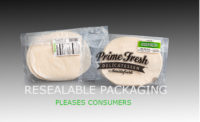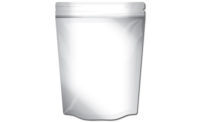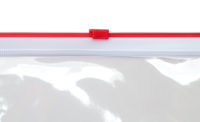Whether a brand owner chooses rigid or flexible packaging, chances are it’s reclosable. Advantages of reclosable packaging are freshness protection, reduction in food waste, consumer convenience and product differentiation. It also may enhance sustainability and offer production efficiencies.
On the rigid side, Chicken of the Sea has launched its Infusions ready-to-eat flavored tuna in a 2.8-ounce, single-serving polypropylene cup, which fits in cup holders. The cup’s primary seal appears to be a foil laminate with a tab for easy peel-off opening. A secondary closure, a color-coded overcap, protects the foil seal and delivers two convenience features. The patented closure not only provides reclosability, but also houses a folded fork, which unfolds and snaps together to serve as a full-size eating utensil. The shrink-sleeve-labeled, reclosable cup also differentiates the product in a section of the store filled with shelves of non-resealable metal cans and retort pouches.
The wild-caught, dolphin-safe tuna infused with extra virgin olive oil, herbs and spices addresses market demand for on-the-go, nutritious snacks and contain 20 grams of protein. Four gluten-free flavors include Thai Chili, Lemon and Thyme, Basil and Sundried Tomato.
Brand owners also are embracing reclosable flexible packaging. Applegate, an independent, standalone subsidiary of Hormel Foods, has been updating its deli packaging with bolder graphics, brighter colors and a peel/reseal feature. The redesigned packaging debuted with Applegate Organics and is moving into its other lines of pre-sliced and packaged deli meats. The company’s website describes how the new easy-open package works.
“1. Locate our “DIG IN AND RESEAL” tab on the front of packaging; centered at the bottom.
2. Gently lift tab up and away so plastic film peels back.
3. Remove as many slices of deli meat as you’d like.
4. Return plastic film to original position, press to reseal, and enjoy remaining slices of deli meat within 3 to 5 days of opening or prior to ‘use-by’ date.”
A tamper-evident feature shows whether the package has been opened. Peeling up the flap tears the bottom corners of the label. The new packaging also scores sustainability points because its smaller size consumes less plastic without affecting the product’s 6-ounce net weight or the number of servings per package (three).
Of course peel/reseal film and overcaps are not the only reclosure options available to brand owners in 2019. For fans of rigid packaging, there are reusable, microwave- and dishwasher-safe polypropylene trays, tubs and bowls with a friction-fit lid for reclosure. The tub/lid design can be produced in various colors to support brand identity and encourages reuse. In fact, if home kitchens across the U.S. were inspected, most probably would contain a collection of these containers awaiting reuse to store leftovers.
Reclosure options for flexible packaging are even more plentiful. Choices include pressure-sensitive peel/reseal labels or tape strips and zipper designs with single narrow or wide press-to-close tracks, multiple press-to-close tracks or sliders, which resemble the zippers used on clothing and can be produced in standard or plastic- and weight-conserving mini sizes. Whether label, tape or zipper, color can enhance shelf impact.
Hook-and-loop press-to-close strips offer yet another possibility. This closure style, however, is most suitable for dry foods and nonfood products. Whatever the reclosure choice, consumers see value. NP





Report Abusive Comment